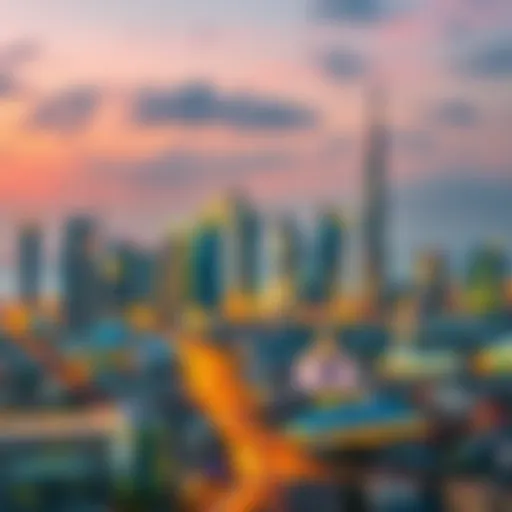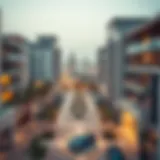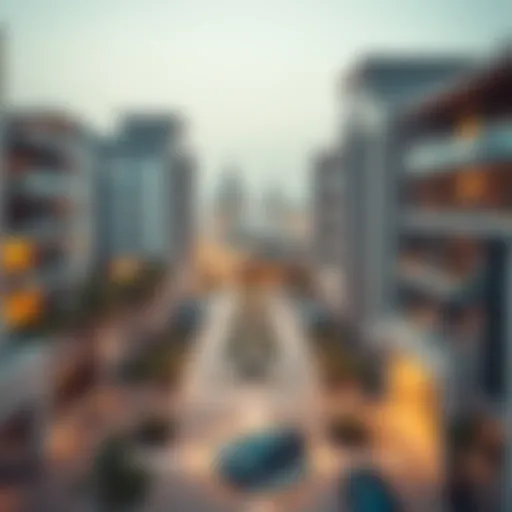Persia's Impact on Dubai's Urban Fabric and Culture
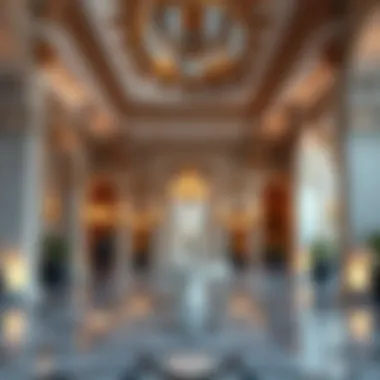

Intro
Dubai, often seen as a gleaming icon of modernity, does not merely rise from the desert sands as a product of contemporary architecture. Instead, it is a complex tapestry woven together by a myriad of influences, not the least of which is the rich and vibrant heritage of Persian culture. To appreciate the contours of Dubai's urban landscape, one must traverse its historical pathways, exploring how the Persian influence has left an indelible mark on Dubai's architectural evolution and multicultural fabric.
The Persian touch can be felt not just in monumental edifices but also in the nuances of social and economic interactions that have transformed Dubai into a thriving international metropolis. The vast expanse of time has allowed for the melding of ancient traditions with modern aspirations, giving rise to a unique identity that is at once global and distinctly local.
This article delves into the very essence of how Persian heritage continues to mold Dubai's progression, highlighting the symbiotic relationship between culture and commerce. By dissecting the intrinsic links between historical contexts and contemporary developments, we propose to unravel the complexities that define Dubai today. From the architectural marvels that echo Persian designs to the bustling markets that reflect centuries-old trade routes, this exploration of Persia's influence on Dubai not only illuminates the city's past but also offers foresight into its future trajectory.
As we navigate through various facets of this rich narrative, we will provide insights that are crucial for investors, homebuyers, realtors, expatriates, and developers alike, aiming to dance between tradition and modernity in this bustling metropolis.
Historical Context of Persia
Understanding the historical context of Persia is vital for grasping how its influences have carved out Dubai's identity today. Not only does it lay the foundational groundwork for deciphering architectural and cultural influences, but it also highlights the multifaceted interactions that have transpired over the centuries. In light of Dubai's rapid transformation into an international metropolis, one can hardly overstate the importance of Persia's past — a rich tapestry of culture, trade, and exchange that feeds into the contemporary urban experience of Dubai.
Overview of Persian Civilization
Persian civilization is one of the most ancient and influential societies, stretching back thousands of years. It flourished across vast regions, from the Middle East to Central Asia, contributing significantly to arts, science, and commerce. The Persian empire was a melting pot, where varying traditions coalesced to form a distinctive culture.
At its height, the Persian Empire fostered advancements in astronomy, mathematics, and literature, setting a high standard in the fields of art and architecture. Think of the impressive ruins of Persepolis, which still evoke awe today. Its ziggurats and complex architectural elegance speak volumes about the ingenuity of ancient Persian society.
The influence of this rich culture seeped into neighboring regions, including the Arabian Peninsula. In examining Dubai's current urban landscape, it becomes clear that the past plays an unignorable role. Persian cuisine, traditions, and social structures set the stage for a vibrant mix of influences that can be witnessed in local customs today.
The Achaemenid Empire's Legacy
The legacy of the Achaemenid Empire, which began in the 6th century BCE, illustrates how deep-rooted Persian influence can be in shaping urban domains. Consider the empire's vast network of roads and trade routes that fostered not just trade but cultural interchange. This legacy paved the way for subsequent civilizations, linking Asia to the Mediterranean.
Persian governance was marked by a relatively progressive stance towards local customs, which allowed for cultural pluralism. This model of incorporation is echoed in Dubai's approach to multiculturalism. Modern Dubai thrives on a similar ethos where diverse nationalities and cultures coexist harmoniously, sparking innovation and economic growth. The Achaemenid model of trade, governance, and cultural synthesis echoes in the very heartbeat of Dubai, showcasing how historical contexts mold modern existence.
Cultural Exchange Between Persia and the Arabian Peninsula
The interactions between Persia and the Arabian Peninsula were marked by an exchange of ideas, goods, and customs. This two-way traffic was not just economic; it brought about significant cultural exchanges. The Silk Road is a prime example, facilitating trade and cultural intermingling for centuries.
Persian literature, particularly the poetic verses of Rumi and Omar Khayyam, found audiences in the Arabian world, influencing local interpretations of art and storytelling. Similarly, Persian art styles affected local craftsmanship, evident in the intricate designs of textiles and ceramics found in Dubai's marketplaces today.
In addition, the Islamic Golden Age, a period during which many ideas were shared between Persian and Arab scholars, left an indelible mark. The melding of philosophies and sciences shaped a unique intellectual environment that would carry influence into future generations.
In summary, the historical context of Persia invites a closer look into how cultural coexistence, innovative governance, and economic strategies laid the groundwork for today’s Dubai. As we navigate these historical currents, we find a clear thread connecting the ancient to the modern, illuminating Dubai's status as an international urban nexus.
Dubai's Emergence as an International City
Dubai's rise to international prominence is not merely a tale of towering skyscrapers and dazzling mall culture. It is a complex narrative woven from threads of history, culture, and innovative thinking. Understanding this evolution is essential for those eyeing investment opportunities in the region, as it underscores the fundamental shifts that have transformed this desert city into a global melting pot.
The Transformation of Dubai's Urban Landscape
The physical transformation of Dubai’s urban landscape has been nothing short of astounding. From a modest fishing village along the Persian Gulf in the early 20th century to a city adorned with architectural marvels, each development speaks volumes of its aspirations. The rapid construction of skyscrapers—each competing more with the horizon than the one beside it—does not just reflect wealth; it embodies the ambition of a city that strives for excellence.
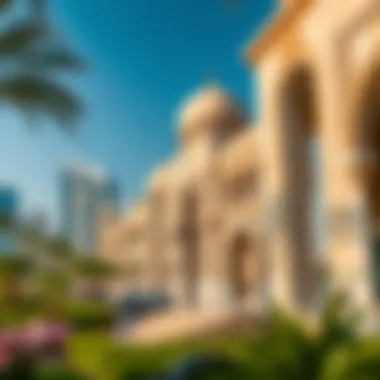

Cities like the Burj Khalifa, the tallest building in the world, are not just structures; they signify a new era of design and ingenuity. The focus on mixed-use developments, such as Dubai Marina and Downtown Dubai, ensures varied living and recreational spaces that cater to an international populace. This evolution is a direct nod to the city’s need for diversity and contentment, as urban spaces should not merely house people but foster community.
Strategic Geographical Location
Dubai's geographical positioning plays a crucial role in its emergence as an international city. Nestled between Europe, Africa, and Asia, it serves as a gateway for trade and tourism alike. This strategic location is enhanced by Dubai International Airport, which is one of the busiest airports in the world.
The convenience of having access to multiple markets from one point provides investors a golden opportunity. This natural advantage is complemented by an advanced infrastructure that pairs world-class highways with public transport systems designed to ease movement for residents and visitors.
Role of Immigration in Urban Growth
A city is often defined by its inhabitants, and Dubai is no exception. Rapid urban growth has been significantly propelled by immigration, with the city now boasting a population where expatriates make up over 80% of the total demographic. This influx of talent and diversity has not only fostered a multicultural environment but has also enriched the city's economy.
*Every corner of Dubai tells a story of its residents—a blend of cultures, traditions, and experiences.
- International cuisines flourish alongside traditional Emirati dishes.
- Artistic expressions, ranging from elaborate street art to sophisticated galleries, showcase a multitude of influences.
Emphasizing its role as a melting pot, the local government has introduced policies to attract skilled labor in sectors like technology, finance, and hospitality. The diverse workforce not only meets the demands of a rapidly evolving economy but also cultivates an innovative spirit that drives urban development forward.
Architectural Influences
The architectural influences of Persia on Dubai form a foundational aspect of the city's development and identity. The historical depth of Persian architecture provides a rich tapestry of elements that have interwoven with contemporary designs in Dubai. These influences can be seen not just in the physical structures, but also in the resourceful ingenuity with which builders and designers have approached urbanization. As Dubai continues to emerge as a modern metropolis, understanding these Persian influences illuminates various aspects including aesthetic choices, urban planning, and cultural integration.
Persian Architectural Elements in Dubai
When inspecting the architectural landscape of Dubai, it is hard to miss the Persian architectural elements that are deeply embedded within the city’s design. These philosophical principles filter into every corner, influencing everything from grandiose buildings to personal homes.
The pointed arches, elaborate ornamental motifs, and intricate tile work characteristic of Persian architecture bring a distinct flavor to Dubai’s urban environment. Moreover, courtyards and gardens echo the Persian tradition, providing spaces of serenity amid the hustle and bustle of city life. For instance, a typical Persian garden, which emphasizes symmetry and water features, finds its way into projects like the expansive Dubai Creek Harbour.
The use of architectural motifs can serve not only as decoration but also as a connection to cultural narratives that enrich the urban environment.
Modern Adaptations of Persian Design
Transitioning to the present, modern adaptations of Persian design in Dubai reflect a blend of tradition and innovation. This fusion has led to the creation of spaces that honor historical significance while meeting contemporary demands.
For example, the modern shopping malls like The Dubai Mall incorporate Persian-inspired features, such as elaborate skylights that resemble traditional Persian domes. As architectural practices evolve, many designers in Dubai find themselves grappling with the challenge of balancing modern functionality with traditional aesthetics. This dichotomy is essential in shaping Dubai's skyline and ensuring its legacy carries forward. Beyond mere aesthetics, these adaptations present various benefits such as sustainability and cultural preservation, fostering a deep respect for the architecture that came before.
Prominent Buildings Reflecting Persian Influence
Several prominent buildings in Dubai stand as testaments to the Persian influence. Consider the Burj Al Arab, with its sail-like silhouette and intricate interior detailing. It embodies a microcosm of Persian design elements, deeply inspired by the country’s opulent architecture and culture. Another significant structure is the Sheikh Zayed Grand Mosque located in neighboring Abu Dhabi, which, although not in Dubai, displays an unmatched grandeur and incorporates several Persian architectural traits, especially in its use of white marble and impressive dome structures that resonate with ancient Persian craftsmanship.
Furthermore, the Palace Downtown captures the essence of Persian influences through its lush gardens and traditional motifs. This hotel is designed not just as a luxurious accommodation but as a cultural statement that intertwines the opulence of Persian legacy with modern guest experience.
As these buildings proliferate, they underscore not only the architectural ethos shared between the two nations but also an appreciation for cultural exchange, fostering a community that values its roots as it strides forward into an uncertain yet exciting future.
Economic Ties: Past and Present
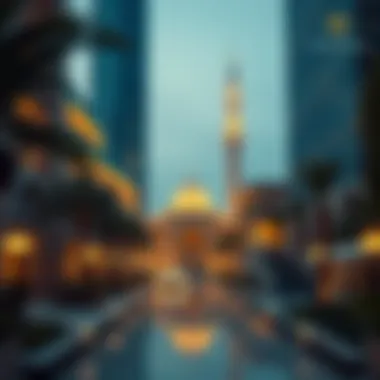

Understanding the economic ties between Persia and Dubai is crucial for grasping how historical relations have shaped modern developments. These ties serve as a backbone for cultural exchanges and trade networks, playing significant roles in the transformation of Dubai into a global city. The relationship has fostered a rich tapestry of opportunities, not just in commerce, but in cultural understanding and urban growth.
Historical Trade Relations with Persia
Historically, the Arabian Peninsula has been notable for its trade routes, with Persian merchants playing pivotal roles. The Gulf's coastal areas were strategic hubs where merchants would exchange goods ranging from spices to textiles. This interaction helped shape the economic landscape of Dubai long before the oil era began.
In bygone years, traders from Persia established routes that linked not just commodities but also ideas and values. Notably, the silk and spice roads fostered connections that transcended simple barter. The influx of Persian influence can be seen in the architecture of traditional souks and the patterns of social gatherings.
In practical terms, this historical trade laid the groundwork for Dubai’s current economic framework. Many business practices and entrepreneurial spirits observed today can trace their roots back to these early exchanges with Persian communities. Wealth was amassed and invested in local initiatives, elevating Dubai's stature as a trading post.
Contemporary Economic Influences
Fast-forward to the present, and the echoes of those ancient trade routes resonate within Dubai’s modern economic strategy. The contemporary ties with Persia and Iran are significant, particularly in sectors like tourism, real estate, and financial services.
The relationship continues to thrive, with expatriates from Iran making up a considerable portion of Dubai's population. This demographic shift has brought about a mix of Persian culture within the social fabric of the city, influencing everything from consumer behavior to cultural events. Economic activities also reflect a duality; not only does Iran invest in Dubai, but Dubai increasingly draws business from Iranian enterprises seeking to branch out.
The ongoing economic interplay means that Dubai serves as a critical jumping-off point for Iranian products and services into broader markets.
Furthermore, businesses in Dubai are registering increased collaborations with Iranian firms, enabling the sharing of expertise, particularly in sectors like emerging technology and healthcare. This collaboration often sees capital flow in both directions, benefiting not only the stakeholders but enriching the local economy.
Impacts on Dubai's Real Estate Market
The real estate market in Dubai profoundly echoes these economic ties. Investors from Iran have been pivotal in shaping the housing landscape, often seeking luxury and high-end properties. The Arabian Gulf region has witnessed a surge in demand for exclusive residential units and commercial developments that offer amenities tailored to Persian tastes.
Moreover, policies that have encouraged foreign investment have led to significant projects, many of which are backed by Iranian financiers. This investment boom has come at a time when Dubai is continually expanding its architectural frontiers, representing a blend of both modern and traditional Persian designs.
On the flip side, the real estate market's robustness has made it a secure investment avenue, providing not just a living space, but a cultural nexus for Iranians abroad. It’s a realm where homes convert into touchstones of community, heritage, and familiarity.
These moves highlight the tight-knit relationship between local economies and cross-border partnerships, suggesting that the future of Dubai's urban development and economy may remain closely interwoven with its Persian heritage as it navigates an increasingly global landscape.
Cultural Intersections
Cultural intersections are vital in understanding the richness and depth of Dubai's identity. As a city that thrives on diversity and multiculturalism, Dubai’s embrace of Persian heritage lies at the core of its societal fabric. It showcases how traditions can blend across borders, enriching communal experiences and contributing to a vibrant urban life.
The importance of recognizing cultural intersections lies in several key aspects:
- Community Bonding: Intertwined traditions foster a sense of belonging. The shared narratives enable residents to connect on deeper levels, enhancing social cohesion.
- Culinary Diversity: The influence of Persian cuisine has led to a delightful amalgamation of flavors, making local dining experiences unique and pleasurable for both residents and visitors.
- Artistic Synergy: Persian art and literature pave the way for a broader appreciation of cultural expressions, enriching Dubai’s artistic landscape.
These intersections serve not just as decorative embellishments but as foundational threads that weave together the stories of different peoples. In this cosmopolitan saga, each cultural influence adds to the whole, allowing for greater understanding amidst diversity.
Persian Traditions in Dubai's Society
Persian traditions have carved a niche in Dubai’s societal framework. Over centuries, the historical connections between the region have led to the adoption of various customs. From Nowruz, the Persian New Year, celebrated with family and friends, to traditional Persian poetry that finds its way into local gatherings, the impact is palpable. Residents cherish these traditions, celebrating them alongside their own cultural practices.
Consider how celebrations pinched with Persian flair incorporate additional food, music, and art. Carpets and rugs, traditionally woven in Persia, have adorned many homes in Dubai, becoming a hallmark of sophisticated decor. This subtle yet profound presence underscores the continuous dialogue between cultures that enriches everyday life.
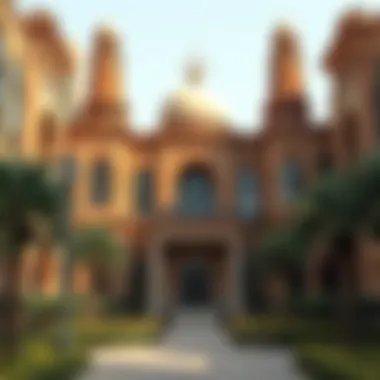

Influence on Local Cuisine and Lifestyle
The culinary scene in Dubai stands as a testament to the profound influence of Persian cuisine. Dishes like kebabs and pistachio saffron rice have become staple offerings in many restaurants across the city, drawing both locals and tourists alike. The warmth of Persian hospitality is evident in how meals are shared, embodying a lifestyle that values togetherness.
Local establishments embrace Persian culinary techniques, which enhances the flavor profiles of traditional Emirati dishes. Due to the blended culture, dining is less about just food and more about creating memories — a social experience that transcends mere sustenance. Additionally, the way people socialize around meals highlights the merging of different values, underlining the significance of community and tradition in an increasingly globalized world.
Art and Literature: A Fusion of Cultures
Art and literature thrive in Dubai, influenced heavily by Persian forms. The intricate calligraphy often seen throughout the Emirate is deeply rooted in Persian styles, echoing an appreciation for linguistic beauty. Visual arts have also taken cues from Persian aesthetics, with exhibitions showcasing works that blend Emirati and Persian thematic elements.
Literary gatherings spark conversations that bring together poets from multiple backgrounds, illuminating the role that words play in bridging cultural divides. The fusion of Persian storytelling with local narratives offers fresh perspectives on age-old tales, encouraging a rich exchange of ideas among various communities.
"Art is the most beautiful of all lies; it does not reflect a single culture, but resonates with many."
The intersections of Persian art, literature, and Dubai's own cultural essence create a dynamic conversation that celebrates diversity while preserving heritage. As we look ahead, this fusion will likely continue to evolve, enriching the urban tapestry of Dubai further.
Future Prospects: Dubai and Persian Influence
The future landscape of Dubai is poised to be significantly shaped by the enduring heritage of Persian culture. Understanding this interplay is crucial for various stakeholders, including investors, homebuyers, developers, and expatriates. As Dubai continues to carve out its identity on the global stage, the Persian influence acts as both a foundation and a bridge, connecting rich traditions with futuristic urban aspirations.
Predictions for Urban Development
Looking ahead, urban development in Dubai will likely reflect a blend of modernity infused with traditional Persian elements. Investors might want to keep an eye on specific trends that showcase this dialogue.
- Architectural Innovation: Expect more structures that marry contemporary engineering with the intricate detailing reminiscent of Persian art. Building designs may incorporate motifs or layouts inspired by ancient Persian gardens, promoting serenity amidst urban hustle.
- Mixed-Use Spaces: Developers might focus on creating multifunctional spaces that encourage community interaction, echoing the traditional Persian marketplaces. These could serve as vibrant hubs for cultural exchange, commerce, and socialization.
- Sustainable Practices: There is also a growing demand for eco-friendly developments. As such, future projects may draw on Persian knowledge of nature-centric design, incorporating elements that prioritize sustainability alongside luxury.
Sustaining Cultural Heritage in a Globalized World
In a rapidly globalizing environment, striking a balance between modern demands and cultural preservation will be essential. Dubai's efforts to sustain its Persian heritage can manifest in several key areas:
- Public Spaces: Investing in parks and plazas that pay homage to Persian gardens may be beneficial for community cohesiveness. These spaces can become venues for cultural events, thus promoting understanding among diverse populations.
- Cultural Institutions: Establishing museums or centers that showcase Persian arts and history can help bridge cultural gaps. This not only preserves the past but also educates future generations and attracts tourists.
- Community Programs: Initiatives that encourage interactions among locals and expatriates can foster a deeper appreciation for Persian traditions. Reserved evenings for art exhibitions or food festivals that celebrate Persian cuisine can play pivotal roles.
The Role of Education and Community Engagement
Education will be a commanding force in shaping Dubai's future in relation to Persian influence. An informed community is vital for nurturing respect and integration:
- Curriculum Development: Schools can incorporate modules on Persian history and culture, highlighting the contributions of this civilization to global narratives. This knowledge equips students with a broader worldview.
- Collaborative Projects: Universities may engage in alliances with Persian institutions to facilitate exchange programs. These endeavors can promote cultural immersion and foster collaborative research on historical ties.
- Community Workshops: Organizing workshops that teach traditional Persian crafts can engage both locals and expatriates, ensuring that these skills are not lost. Such efforts reinforce community bonds while nurturing interest in cultural heritage.
The ongoing relationship between Dubai and its Persian past is not merely an interplay of memory; it is a powerful narrative that shapes the city's identity and future trajectory.
Closure
In the grand narrative of urban development, the significance of understanding Persia's influence on Dubai cannot be overstated. It’s not just about bricks and mortar, but the legacy embedded within the architectural aesthetics, cultural nuances, and economic frameworks that make up today's Dubai. This exploration reveals that the interplay between Persian heritage and Saudi urban growth creates a rich tapestry of influences that have moulded the emirate into a cosmopolitan hub.
Summary of Findings
The survey conducted throughout the article highlights several critical elements that define this influence:
- Historical Connections: The Achaemenid Empire laid a foundation for trade connectivity between Persia and the Arabian Peninsula, impacting economic relations that continue today.
- Cultural Exchange: The mingling of Persian traditions with local customs manifests in Dubai's culinary scene, artistic endeavors, and lifestyle choices, revealing a vibrant multicultural society.
- Architectural Blending: Persian elements are not merely decorative; they shape functional spaces, with modern adaptations seen in structures like the Burj Khalifa and the Sheikh Zayed Road skyline.
- Current Economic Ties: Trade routes established centuries ago still resonate in modern real estate dynamics, influencing investment trends among expatriates and property developers.
"The pulse of a city is felt through its history, and Dubai beats in rhythm with its Persian roots."
Final Thoughts on Persia's Impact
When considering the future trajectory of Dubai, it’s essential to acknowledge the persistent undercurrents of Persian influence. This cultural cousin enriches the city's identity, reflecting how historical legacies can stimulate modern innovation. Investors and expatriates keen on tapping into Dubai's potential must appreciate this background. It’s a prism through which one can understand the nuances of engagement within this breathtaking urban environment. As globalization continues to reshape communities, sustaining this cultural dialogue becomes vital in nurturing the identity that has been so intricately woven through time.
As Dubai strides forward, the echoes of Persia will likely remain a crucial compass guiding its multifaceted development, ensuring that both heritage and modernity coexist harmoniously.

